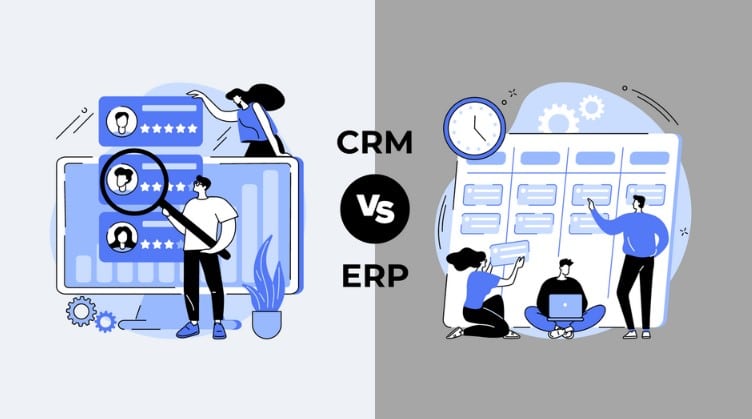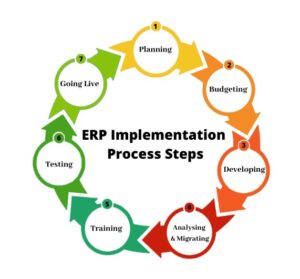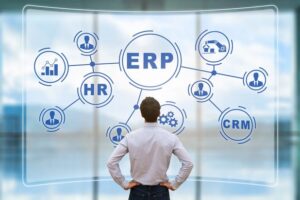In the dynamic world of business technology, acronyms like ERP and CRM are thrown around frequently. Understanding ERP vs CRM: Key Differences is essential for decision-makers navigating the software landscape. In this article, we will delve deep into Enterprise Resource Planning (ERP) and Customer Relationship Management (CRM) systems, highlighting their unique features, benefits, and use cases. By the end, you’ll have a crystal-clear understanding of these two powerful tools and which one aligns best with your business objectives.
ERP vs CRM: A Head-to-Head Comparison
When it comes to understanding ERP vs CRM, it’s essential to delve into a detailed comparison of these two fundamental business software systems. While both ERP (Enterprise Resource Planning) and CRM (Customer Relationship Management) play crucial roles in modern businesses, they serve vastly different purposes and have distinct functionalities. Let’s take a closer look at how they stack up against each other:
Scope and Functionality
ERP: Enterprise Resource Planning systems are comprehensive software solutions designed to manage a wide array of core business functions. These functions encompass everything from financial management, human resources, supply chain management, production, and inventory control. ERP acts as the backbone of an organization, offering a centralized platform for various departments to collaborate and share data efficiently. It aims to streamline processes, improve productivity, and provide real-time insights into overall business operations.
CRM: Customer Relationship Management systems, on the other hand, have a narrower focus. They are primarily designed to manage and nurture relationships with customers. CRM software centralizes customer data, tracks interactions, and facilitates communication with clients. The main goal of CRM is to enhance customer satisfaction, increase sales, and foster customer loyalty.
Data Usage
ERP: In the context of ERP, data is predominantly used for internal purposes. ERP systems facilitate data-driven decision-making, optimize resource allocation, and streamline business processes. The data collected and analyzed within an ERP system typically pertains to an organization’s internal operations and performance.
CRM: CRM systems primarily leverage data for external purposes. They focus on improving interactions with customers and prospects. CRM software stores information related to customer behavior, preferences, and communication history. This data is then used to personalize marketing efforts, sales strategies, and customer support, ultimately leading to better customer relationships.
Primary Users
ERP: ERP systems are designed to cater to a wide range of users across different departments within an organization. This includes finance professionals, human resources personnel, production managers, and supply chain executives. ERP’s expansive functionality ensures that it serves the needs of various teams.
CRM: CRM systems, in contrast, are primarily used by sales and marketing teams, as well as customer support representatives. These departments rely on CRM to manage leads, track sales opportunities, and provide efficient customer service. CRM software is tailored to meet the specific requirements of customer-centric roles.
Integration
ERP: One of the hallmarks of ERP systems is their seamless integration of various modules and functions. This integration ensures that data is consistent across the organization, eliminating data silos. ERP’s ability to connect different parts of a business enhances overall operational efficiency.
CRM: While CRM systems can integrate with other software and tools, they are often standalone systems that focus primarily on customer-centric activities. They provide a centralized platform for managing customer-related data and interactions, but their integration capabilities are more limited compared to ERP.
Business Impact
ERP: Implementing an ERP system can have a significant impact on a business. It typically leads to improved operational efficiency, reduced operational costs, and better decision-making through data analytics. ERP helps organizations optimize their resources and processes, ultimately contributing to increased profitability.
CRM: CRM systems are instrumental in enhancing customer relationships. They lead to increased customer satisfaction, higher sales conversion rates, and improved customer retention. By providing insights into customer preferences and behaviors, CRM empowers businesses to tailor their marketing and sales efforts, resulting in increased revenue.
In conclusion, while both ERP and CRM systems are essential for modern businesses, they serve distinct purposes. ERP focuses on optimizing internal operations and resource management, while CRM is dedicated to building and nurturing customer relationships. The choice between ERP and CRM depends on an organization’s specific needs and objectives. In some cases, businesses may benefit from implementing both systems to leverage their unique strengths and create a well-rounded approach to managing their operations and customer interactions.
Understanding ERP vs CRM: Key Differences

To gain a comprehensive grasp of the key differences between Enterprise Resource Planning (ERP) and Customer Relationship Management (CRM) systems, let’s explore these two essential business software solutions in greater detail. While they may seem similar on the surface due to their acronym-laden names, ERP and CRM serve distinct purposes, catering to different aspects of a business’s operations. Here’s a more in-depth examination of their unique characteristics:
ERP Unveiled
Enterprise Resource Planning (ERP) is an all-encompassing software suite designed to act as the central nervous system of a business. Its primary mission is to streamline and optimize various core functions within an organization. ERP systems are characterized by their ability to integrate and manage a wide array of business processes, including but not limited to:
- Financial Management: ERP modules handle accounting, budgeting, payroll, and financial reporting, ensuring the financial health of the company is in check.
- Human Resources: HR functions such as employee records, payroll management, benefits administration, and talent acquisition are efficiently managed within an ERP system.
- Supply Chain Management: ERP systems oversee procurement, inventory control, and logistics, ensuring products flow smoothly from suppliers to customers.
- Production and Manufacturing: Manufacturing processes, quality control, and production scheduling are optimized through ERP functionalities.
- Inventory Management: Real-time tracking of inventory levels and stock movement enables efficient stock control and order fulfillment.
- Sales and Distribution: ERP streamlines sales processes, from order entry to delivery, enhancing customer satisfaction.
- Analytics and Reporting: Data-driven decision-making is facilitated by ERP’s robust analytics and reporting capabilities.
CRM Explored
Customer Relationship Management (CRM), as the name suggests, revolves around managing and nurturing relationships with customers and clients. CRM software focuses on enhancing interactions with individuals and organizations external to the company. Its primary objectives include:
- Centralizing Customer Data: CRM systems create a centralized repository for customer information, ensuring a 360-degree view of customer interactions.
- Sales Management: CRM aids sales teams by tracking leads, opportunities, and sales activities, thereby boosting sales efficiency.
- Marketing Automation: CRM enables targeted marketing campaigns, automating lead generation, email marketing, and customer segmentation.
- Customer Service: CRM facilitates efficient customer support by managing customer inquiries, complaints, and requests, ultimately enhancing customer satisfaction.
- Analytics and Insights: CRM systems provide valuable insights into customer behavior and preferences, allowing for data-driven marketing and sales strategies.
Key Differences
Now that we’ve explored the core functionalities of ERP and CRM, let’s highlight the key differences between these two vital systems:
1. Scope and Focus
- ERP: Broad and comprehensive, ERP systems cover a wide range of internal business functions, making them ideal for organizations seeking to streamline operations, improve efficiency, and achieve cost savings.
- CRM: Focused on external relationships, CRM software centers on customer-related activities, making it invaluable for businesses aiming to enhance customer satisfaction, boost sales, and foster customer loyalty.
2. Data Usage
- ERP: Primarily utilizes data for internal purposes, aiding in decision-making, resource allocation, and process optimization within the organization.
- CRM: Leverages data predominantly for external purposes, focusing on improving interactions with customers, tailoring marketing efforts, and driving sales growth.
3. Primary Users
- ERP: Used by employees across various departments, including finance, HR, manufacturing, and logistics, ERP serves a wide array of internal functions.
- CRM: Mainly employed by sales, marketing, and customer support teams, CRM systems are essential tools for those managing customer relationships and sales activities.
4. Integration
- ERP: Renowned for its seamless integration of multiple modules and functions, ERP ensures data consistency across the organization, breaking down silos.
- CRM: While CRM can integrate with other software, its primary focus is on managing customer-centric activities, making it more of a standalone system.
5. Business Impact
- ERP: Leads to operational efficiency, cost reduction, and enhanced decision-making, ultimately contributing to improved profitability and competitiveness.
- CRM: Enhances customer satisfaction, increases sales conversion rates, and improves customer retention, driving revenue growth and strengthening brand loyalty.
In conclusion, while both ERP and CRM systems play pivotal roles in modern business operations, their distinct features and areas of concentration make them valuable in different ways. Choosing between the two depends on an organization’s specific goals and requirements. In some cases, businesses may opt to implement both systems to harness the combined power of comprehensive internal management and customer-centric relationship-building. Understanding the nuances of ERP vs CRM is essential for making informed decisions that align with your company’s strategic objectives.
FAQs
Can a business benefit from both ERP and CRM systems?
Absolutely! Many businesses use both ERP and CRM systems to capitalize on the strengths of each. ERP manages internal processes, while CRM focuses on external relationships, creating a powerful synergy.
How do ERP and CRM systems improve data accuracy?
ERP systems maintain data consistency by eliminating duplicate entries and automating data updates. CRM systems enhance data accuracy by providing a single source of truth for customer information.
Are ERP and CRM systems only for large enterprises?
No, both ERP and CRM solutions come in various sizes and configurations, making them suitable for businesses of all sizes, from small startups to large corporations.
Can ERP and CRM systems be customized to suit specific business needs?
Yes, most ERP and CRM systems offer customization options to tailor the software to your unique requirements.
How long does it take to implement ERP or CRM software?
The implementation timeline varies depending on the complexity of your business processes and the size of your organization. It can range from several months to a year or more.
Are there any industry-specific ERP or CRM solutions available?
Yes, many ERP and CRM vendors offer industry-specific solutions designed to meet the unique needs of various sectors, such as manufacturing, healthcare, or retail.
Conclusion
In the ever-evolving landscape of business technology, Understanding ERP vs CRM: Key Differences is pivotal. ERP and CRM systems are powerful tools, each with its distinct focus and advantages. As you consider implementing one or both of these systems, weigh your business requirements and objectives carefully. Remember that the right choice can drive efficiency, productivity, and customer satisfaction to new heights.


